小升初英语句型转换最全汇总
小升初英语专项复习之句型转换
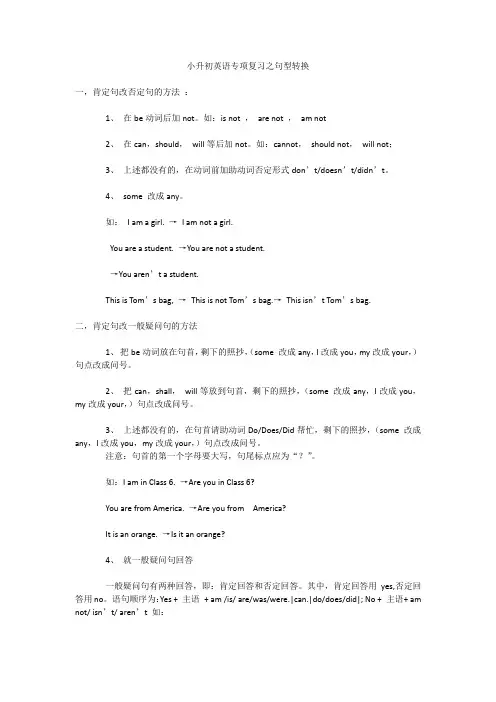
小升初英语专项复习之句型转换一,肯定句改否定句的方法:1、在be动词后加not。
如:is not ,are not ,am not2、在can,should,will等后加not。
如:cannot,should not,will not;3、上述都没有的,在动词前加助动词否定形式don’t/doesn’t/didn’t。
4、some 改成any。
如:I am a girl. →I am not a girl.You are a student. →You are not a student.→You aren’t a student.This is Tom’s bag, →This is not Tom’s bag.→This isn’t Tom’s bag.二,肯定句改一般疑问句的方法1、把be动词放在句首,剩下的照抄,(some 改成any,I改成you,my改成your,)句点改成问号。
2、把can,shall,will等放到句首,剩下的照抄,(some 改成any,I改成you,my改成your,)句点改成问号。
3、上述都没有的,在句首请助动词Do/Does/Did帮忙,剩下的照抄,(some 改成any,I改成you,my改成your,)句点改成问号。
注意:句首的第一个字母要大写,句尾标点应为“?”。
如:I am in Class 6. →Are you in Class 6?You are from America. →Are you from America?It is an orange. →Is it an orange?4、就一般疑问句回答一般疑问句有两种回答,即:肯定回答和否定回答。
其中,肯定回答用yes,否定回答用no。
语句顺序为:Yes + 主语+ am /is/ are/was/were.|can.|do/does/did|; No + 主语+ am not/ isn’t/ aren’t 如:—Are you an English teacher?→Yes, I am. /No, I am not.—Is that a bird? →Yes, it is./ No, it isn’t.三,对划线部分提问“就划线部分提问”是小学阶段英语学习的难点,但是一旦掌握了规律,就变得容易多了。
小升初重要知识点归纳常见句型与句式转换技巧

小升初重要知识点归纳常见句型与句式转换技巧一、常见句型归纳1. 主谓结构句型:主语+动词例如:他吃苹果。
→ 苹果被他吃了。
2. 主谓宾结构句型:主语+动词+宾语例如:我喜欢读书。
→ 读书是我喜欢的。
3. 主谓补结构句型:主语+动词+补语例如:他是个老师。
→ 他成为了老师。
4. 宾语从句句型:主句+动词+从句例如:我知道他在哪里。
→ 我知晓他在何处。
5. 同位语句型:名词+同位语例如:他是篮球明星姚明。
→ 姚明是著名的篮球明星。
二、句式转换技巧1. 句子逆序:将句子的主语和谓语部分调换位置。
例如:I love swimming. → Swimming is loved by me.2. 主动态转被动态:将句子的主动态改为被动态,同时改变主语和谓语形式。
例如:He plays football. → Football is played by him.3. 被动态转主动态:将句子的被动态改为主动态,同时改变主语和谓语形式。
例如:The book was written by her. → She wrote the book.4. 直接引语转间接引语:将直接引语改为间接引语,并相应修改动词和人称。
例如:"I am happy," he said. → He said that he was happy.5. 定语从句转定语从句:将定语从句转换为非限制性定语从句。
例如:The boy who is wearing a blue jacket is my brother. → The boy, wearing a blue jacket, is my brother.6. 条件句转换:将条件句从虚拟语气转换为陈述语气,或者反过来。
例如:I f it rains tomorrow, we won't go to the park. → We won't go to the park if it rains tomorrow.以上是小升初重要知识点中常见句型的归纳以及句式转换的技巧。
小升初句型转换总结(基础)
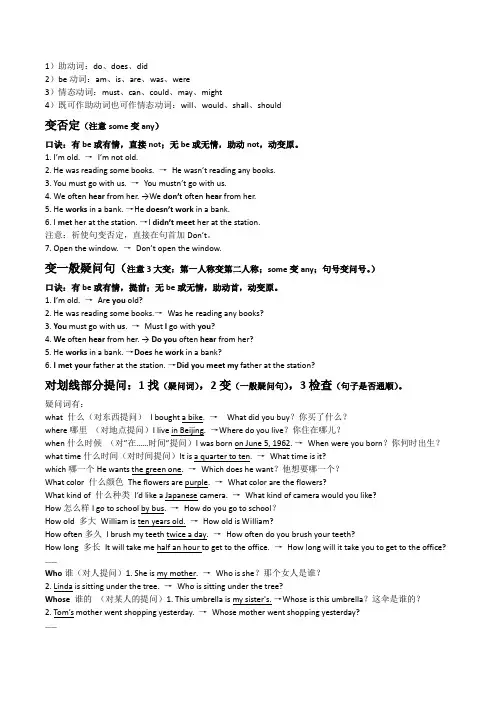
1)助动词:do、does、did2)be动词:am、is、are、was、were3)情态动词:must、can、could、may、might4)既可作助动词也可作情态动词:will、would、shall、should变否定(注意some变any)口诀:有be或有情,直接not;无be或无情,助动not,动变原。
1. I’m old. →I’m not old.2. He was reading some books. →He was n’t reading any books.3. You must go with us. →You mustn’t go with us.4. We often hear from her. →We don’t often hear from her.5. He works in a bank. →He doesn’t work in a bank.6. I met her at the station. →I didn’t meet her at the station.注意:祈使句变否定,直接在句首加Don’t。
7. Open the window. →Don’t open the window.变一般疑问句(注意3大变:第一人称变第二人称;some变any;句号变问号。
)口诀:有be或有情,提前;无be或无情,助动首,动变原。
1. I’m old. →Are you old?2. He was reading some books.→Was he reading any books?3. You must go with us. →Must I go with you?4. We often hear from her. →Do you often hear from her?5. He works in a bank. →Does he work in a bank?6. I met your father at the station. →Did yo u meet my father at the station?对划线部分提问:1找(疑问词),2变(一般疑问句),3检查(句子是否通顺)。
小升初英语语法 句型转换--
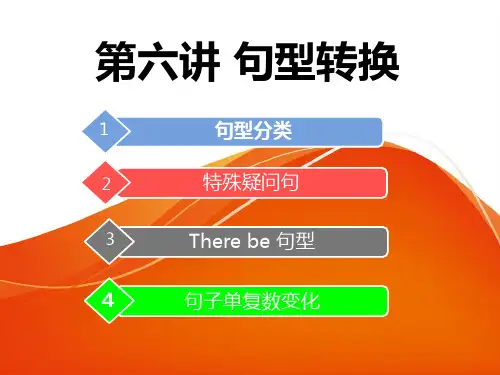
4.以f或fe结尾的名词变复数
可数名词的单数变复数(不规则变化)
1.单复数同形的名词:
Chinese Japanese sheep fish deer
2.单复数不同形(特殊名词的变化):
1)改变中间元音 foot—feet tooth—teeth mouse-mice man—men woman—women 2)词尾加ren child—children
可数名词的单数变复数(规则变化)
1.直接在名词后加~s
例:cake---cakes, leg---legs
2.在以s, sh, ch, x 结尾的名词后加~ es
例: dress-dresses, dish-dishes, watch-watches, box---boxes
3.以o结尾的名词,一般加~s ,
第六讲 句型转换
1
句型分类
特殊疑问句 There be 句型 句子单复数变化
2
3
4
1
句型转换
肯定句 He is a student. 否定句 He is not a student. 一般疑问句 Is he a student? 肯定回答 Yes, he is . 否定回答 No, he isn't. 特殊疑问句句: What is he?
所有格的构成方式
1.由名词加’s构成,通常用来表示 有生命的东西 2.由 of加名词构成,通常用来表示没 有生命的东西
真题精讲一:(2012年稼轩中学小升初真题)
A.根据图片完成单词,请将所缺字母填入字谜的空格中。
B. 根据句意将上题5个单词的标号A B C D E分别填入句子中,每个标号 限用一次。 1. _____________ works in a police station and helps people. 2. Langlang plays the ____________ every day. 3. I often row a _______ at Daming Lake on the weekends. 4. Spring is a good reason to fly a _______. 5. I got a beautiful _________ on my 12th birthday.
小升初英语句型转换篇
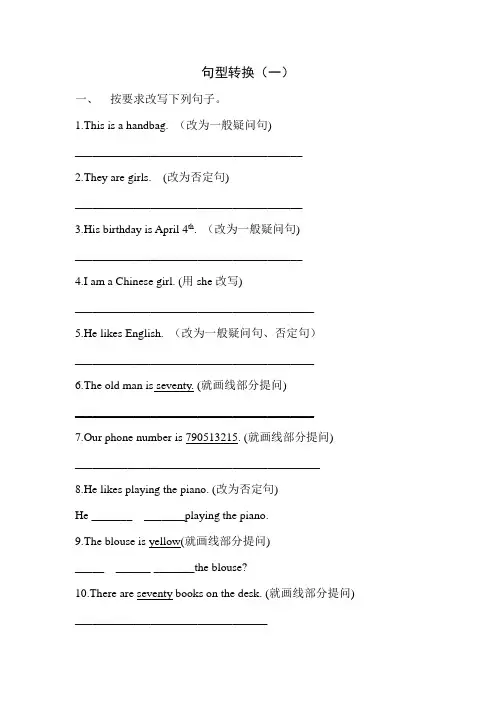
句型转换(一)一、按要求改写下列句子。
1.This is a handbag. (改为一般疑问句)_______________________________________2.They are girls. (改为否定句)_______________________________________3.His birthday is April 4th. (改为一般疑问句)_______________________________________4.I am a Chinese girl. (用she改写)_________________________________________5.He likes English. (改为一般疑问句、否定句)_________________________________________6.The old man is seventy. (就画线部分提问)_________________________________________7.Our phone number is 790513215. (就画线部分提问)__________________________________________8.He likes playing the piano. (改为否定句)He _______ _______playing the piano.9.The blouse is yellow(就画线部分提问)_____ ______ _______the blouse?10.There are seventy books on the desk. (就画线部分提问) _________________________________11.There are some pencils on the table. (改为否定句)_____ _________ ________pencils on the table?12. She does her homework every morning.(改为否定句)She_________ ________her homework very morning. 13.That is a box.(改为复数句)__________________________________________14.I have some baseball bats.(改为一般疑问句)____________________________________________15.Kate has some money in her pocket.(改为否定句)16.I usually go to school on weekdays.(就画线部分提问)__________do you usually _____on weekdays.17.They go to bed early.(改为一般疑问句)__________they_______to bed early?18.Are there any eggs in the fridge?(改为肯定陈述句)_______ ______ ______eggs in the fridge.19.Is your mother a doctor?(用teacher改为选择疑问句)_______________________________________20.There are forty classrooms in the building.(就画线部分提问) ______________________________________21.Open your textbooks ,please.(改为否定句)_______________________________________22.It’s eleven thirty. (就画线部分提问)__________the_______,please?23.There are some pears on the table? (改为一般疑问句)_______there_____pears on the table?24.My grandpa goes to the park every Sunday.(用next 代替every) My grandpa _____ _____ to the park next Sunday。
2024年小升初六年级英语专题复习:句型转换
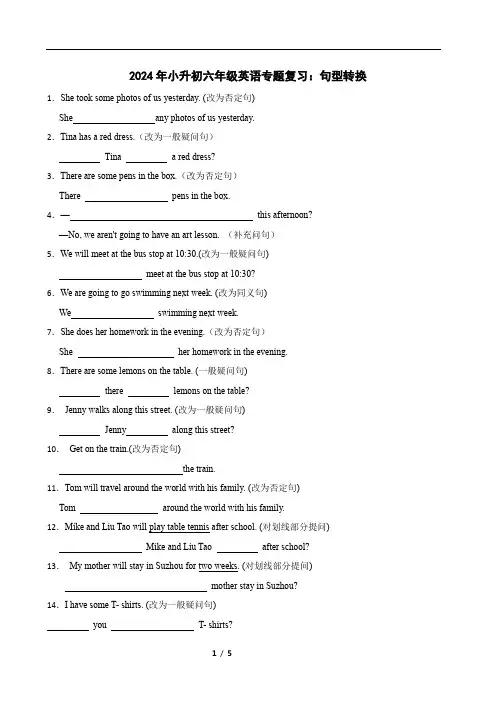
2024年小升初六年级英语专题复习:句型转换1.She took some photos of us yesterday. (改为否定句)She any photos of us yesterday.2.Tina has a red dress.(改为一般疑问句)Tina a red dress?3.There are some pens in the box.(改为否定句)There pens in the box.4.—this afternoon?—No, we aren't going to have an art lesson. (补充问句)5.We will meet at the bus stop at 10:30.(改为一般疑问句)meet at the bus stop at 10:30?6.We are going to go swimming next week. (改为同义句)We swimming next week.7.She does her homework in the evening.(改为否定句)She her homework in the evening.8.There are some lemons on the table. (一般疑问句)there lemons on the table?9.Jenny walks along this street. (改为一般疑问句)Jenny along this street?10.Get on the train.(改为否定句)the train.11.Tom will travel around the world with his family. (改为否定句) Tom around the world with his family.12.Mike and Liu Tao will play table tennis after school. (对划线部分提问)Mike and Liu Tao after school?13.My mother will stay in Suzhou for two weeks. (对划线部分提问)mother stay in Suzhou?14.I have some T- shirts. (改为一般疑问句)you T- shirts?15.We go to school from Monday to Friday. (改为一般疑问句)go to school from Monday to Friday?16.Miss Li is writing about her students' dreams. (对划线部分提问)is Miss Li writing about?17.She is going to bring some snacks to me next week. (用last week 改写) She snacks to me last week.18.There is a house in the forest. (改为一般疑问句)a house in the forest?19.There are some cakes in the fridge.(改为否定句)There cakes in the fridge.20.She is a teacher. (对划线部分提问)job?21.Is that a strawberry? (做肯定回答)Yes,.22.There is some soup in the pot.(改为一般疑问句)soup in the pot?23.The prince sees a shoe on the floor.(对划线部分提问)a shoe on the floor?24.Daisy read her book report after dinner.(改为一般疑问句)Daisy her book report after dinner? 25.Nancy's parents wake her up every morning.(对划线部分提问)Nancy up every morning?26.Su Hai always puts her things in order.(改为否定句)Su Hai her things in order.27.Mike often washes his face before breakfast.(对划线部分提问)Mike before breakfast? 28.The well is very deep.(对划线部分提问)the well?29.Jack didn't do well in English three years ago.(改为同义句) Jack English three years ago.30.The mouse made a big hole.(改为一般疑问句)the mouse a big hole?31.The farmer caught the wolf with a large net.(改为同义句)The farmer a large net the wolf.32.The mouse woke the lion up.(对划线部分提问)the lion ?33.Tim, drink some cold water. (改为否定句)Tim, cold water.34.He can't eat these mushrooms because they are bad for him. (对划线部分提问)he eat these mushrooms?35.She walks along this street.(改为一般疑问句)she along this street?答案解析部分1.【答案】didn't;take2.【答案】Does;have3.【答案】aren't;any4.【答案】Are you going to have an art lesson5.【答案】Will;you6.【答案】will;go7.【答案】doesn't;do8.【答案】Are;any9.【答案】Does;walk10.【答案】Don't;get;on11.【答案】won't travel12.【答案】What;will;do13.【答案】How long;will;your14.【答案】Do;have;any15.【答案】Do;you16.【答案】What17.【答案】brought;some18.【答案】Is;there19.【答案】aren't;any20.【答案】What's;her21.【答案】it;is22.【答案】Is;there;an23.【答案】Who;sees24.【答案】Did;read25.【答案】Who;wakes26.【答案】never;puts27.【答案】What;does;often;do28.【答案】How;is29.【答案】wasn't;good;at30.【答案】Did;make 31.【答案】used;to catch 32.【答案】Who;woke;up 33.【答案】don't;drink;any 34.【答案】Why;can't 35.【答案】Does;walk。
小升初英语语法复习——句型转换
第一节 单数句变复数句【知识梳理】单数句变复数句歌谣:单数句变复数句, 代词四变要记住。
人称,指示,反身变 物主代词看一看。
连系动词 am is 变成 are 。
冠词a an 要去掉,改为some, any 也可以。
名词做定语,介宾不要变;有man 和woman 也例外。
句式不要变,十全十美题做完。
1例1 She is a girl . They are girls .例2 I like her. We like them.2 、指示代词由单数变复数:例1 This is a book . These are (some )books .例2 Is that a pen ? Are those (any )pens ?3、反身代词:第一人称 myself ourselves第二人称 yourself yourselves第三人称 himself themselves( herself, itself )【例题精讲】例1 I am teaching myself computer.We are teaching ourselves computer.例2 The child himself draws this picture.The children themselves draw these pictures.4、 物主代词由单数变复数:1名词性物主代词:mine ours ,yours yours , his/hers/its theirs2 形容词性物主代词:my our ,your your ,his/her/its their例1 The book is mine. The books are ours.例2 This is her pen. These are their pens.5、 一般情况下,形容词性物主代词在单数句变复数句时不变。
例1 This is my book . These are my books .6、当句中形容词性物主代词与句中的主语一致时,形容词性物主代词应随主语人称的变化而变化,仍要保持一致。
(完整word版)小升初英语所有句型转换的方法(部分有答案)(A4打印版)
小学英语所有句型转换的方法(A4打印版)1、将is,are,am移位到句首.如有I、you将其该成you、I。
(疑问句)2、划线部分提问:句中不能出现划线部分,但将划线部分转成疑问词.划线部分提问:句中不能出现划线部分,但将划线部分转成疑问词.将陈述句变成启示句将陈述句变成疑问句一般疑问句,就是将一般疑问词提到句首。
没有一般疑问(am is are)就加上助动词放在句首。
然后句子中间注意要改变的地方。
比如说,如果是一句以第三人称来写的陈述句。
那一些动词后面会加上s、es。
如果要改成一般疑问句,句子里面又必须将助动词does(第三人称单数)放在句首作一般疑问句的话,那改变的时候,动词后面就必须去s、es。
然后就是some和any的事情,陈述句用some,一般疑问句用any。
但是一小部分一般疑问句里面,看到some,一般疑问句也是要改some的。
在这句句子是……比如说想要什么东西,一般疑问句里面就要用some。
还有一种是特殊疑问句,题目一般是划线提问。
根据划线的词语选用特殊疑问词,放在句首,进行提问。
特殊疑问词一般是w或wh开头的。
如:what \how\ who\ how many \how much \what colour\howold\which\why……等等……小学里面疑问句最主要的就是这些了。
小学英语所有句型转换的方法基本助动词只有三个:be, do, have, 他们没有词汇意义,只有语法作用,如协助构成进行体,完成体,被动态,否定句,疑问句等。
肯定句改否定句的方法口诀一找(be动词和情态动词),二不(not)句中有be动词或情态动词can 时。
句中既没be动词也没情态动词can时。
主语若是第三人称单数,does来帮忙。
若不是,找do 帮忙。
do或does后直接再加not.就可以注意,some要改成any口诀诠释:1、在be动词后加not。
如:is not ,are not ,am not,was not,were not;2、在can,should,will等后加not。
小升初英语所有句型转换的方法(部分有答案)(A4打印版)
小学英语所有句型转换的办法(A4打印版)之老阳三干创作1、将is,are,am移位到句首.如有I、you将其该成you、I.(疑问句)2、划线部分提问:句中不克不及出现划线部分,但将划线部分转成疑问词.划线部分提问:句中不克不及出现划线部分,但将划线部分转成疑问词.将陈述句酿成启示句将陈述句酿成疑问句一般疑问句,就是将一般疑问词提到句首.没有一般疑问(am is are)就加上助动词放在句首.然后句子中间注意要改动的地方.比方说,如果是一句以第三人称来写的陈述句.那一些动词后面会加上s、es.如果要改成一般疑问句,句子里面又必须将助动词does(第三人称单数)放在句首作一般疑问句的话,那改动的时候,动词后面就必须去s、es.然后就是some和any的事情,陈述句用some,一般疑问句用any.但是一小部分一般疑问句里面,看到some,一般疑问句也是要改some的.在这句句子是……比方说想要什么东西,一般疑问句里面就要用some.还有一种是特殊疑问句,题目一般是划线提问.按照划线的词语选用特殊疑问词,放在句首,进行提问.特殊疑问词一般是w或wh开头的.如:what \how\ who\ how many \how much \whatcolour\how old\which\why……等等……小学里面疑问句最主要的就是这些了.小学英语所有句型转换的办法基本助动词只有三个:be, do, have, 他们没有词汇意义,只有语法作用,如协助组成进行体,完成体,主动态,否认句,疑问句等.肯定句改否认句的办法口诀一找(be动词和情态动词),二不(not)句中有be动词或情态动词can 时.句中既没be动词也没情态动词can时.主语若是第三人称单数,does来辅佐.若不是,找do 辅佐.注意,some要改成any口诀诠释:1、在be动词后加not.如:is not , are not , am not, was not, were not;2、在can,should, will等后加not.如:cannot, should not, will not;3、上述都没有的,在动词前加助动词否认形式don’t/doesn’t/didn’t.4、 some 改成any.肯定句改一般疑问句的办法口诀“是”“情”“助”提句首,没有它们do和does来当,三单形式要还原.some改成any,第一人称变第二人称.最后句号改问句莫忘记.一般回答在句首,Yes或No先用上.口诀诠释:1、把be动词放在句首,剩下的照抄,(some 改成any,my改成your等)句点改成问号.2、把can,shall, will等放到句首,剩下的照抄,(some 改成any,my改成your等)句点改成问号.例如:陈述句: They are in the park. He can play the guitar..一般疑问句: Are they in the park? 例如:陈述句: I like the ducks. He likes the dogs.一般疑问句:Do you like the ducks? Does he like the dogs?Can he play the guitar?三、肯定句改特殊疑问句的办法——四步法1、在一般疑问句的基础上,句首添加一个疑问词即可,可按照划线部分确定是什么疑问词.2、接着找be动词或can,shall, will等放在疑问词后面,若没有则请助动词do/does/did辅佐,写在疑问词后面,how many除外,必须先写物品,再写be动词等.3、划线部分去掉后剩下的内容照抄,(some 改成any,my改成your等)4、句点改成问号.关于特殊疑问词组针对人提问(谁) who地点(何地) where时间(何时) when what time方法办法程序(怎样) how年龄 how old可数名词问多少 How many不成数名词问多少,多少钱 How much东西职业事物(什么) what颜色 what color班级 what class年级 what grade时间 what time选择某个 whichwhich class前人云“授人鱼,不如授人渔.”前人尚且知道授人知识不如授人办法的道理,那么在各类理论高度成长的今天为什么就不克不及多重视一点办法和传授呢?句子教学是英语教学中的重要环节,有了句子作为基础,学生才干学好英语,也才干真正运用英语.在几年的英语教学中,我总结了一些英语句子教学的小窍门,现简单归纳如下:一、肯定句改否认句的办法——一步法1、在be动词后加not.如:is not , are not , am not,was not, were not;2、在can,should, will等后加not.如:cannot, shouldnot, will not;3、上述都没有的,在动词前加助动词否认形式don’t/doesn’t/didn’t.4、 some 改成any.二、肯定句改一般疑问句的办法——三步法1、把be动词放在句首,剩下的照抄,(some 改成any,my改成your等)句点改成问号.2、把can,shall, will等放到句首,剩下的照抄,(some 改成any,my改成your等)句点改成问号.3、上述都没有的,在句首请助动词Do/Does/Did辅佐,剩下的照抄,(some 改成any,my改成your等)句点改成问号.三、肯定句改特殊疑问句的办法——四步法1、在一般疑问句的基础上,句首添加一个疑问词即可,可按照划线部分确定是什么疑问词.2、接着找be动词或can,shall, will等放在疑问词后面,若没有则请助动词do/does/did辅佐,写在疑问词后面,how many除外,必须先写物品,再写be动词等.3、划线部分去掉后剩下的内容照抄,(some 改成any,my改成your等)4、句点改成问号.总之,要教好句子,首先要给学生渗透句子的纲,学生才可以依葫芦画瓢,有纲可循.当然,平时还必须增加阅读量,实践量,不竭总结经验,培养语感掌握技巧,提高句子的准确性.句型转换解题要点123在我们的日常教学过程中,为检验学生对于句型或语法的掌握程度,句型转换是一个重要的练习稳固和检测手段.但是在学生的作业上,我们常发明在做这类题目的时候学生往往找不到头绪,这也可能与我们比较注重听说而忽视语法所造成的结果.但是我们清楚的知道,要成为一个好的英语学习者,不合错误语法时态有清晰的认识的话是很难有所突破的.所以针对这种现象,让学生能通过练习找到属于自己的正确的解题思路,我对小学英语阶段句型转换的解题要点做了如下归纳.一、句型转换题分“按要求转换句型”和“同义句转换”两部分.如何做句型转换题呢?我们还是看看下面的例子吧.1、肯定句酿成否认句或一般疑问句时应注意的问题:把含有be动词、助动词和情态动词的句子改成否认句时,只须在这些动词后加not;如果要求把此类句子酿成一般疑问句,则须将be动词、助动词和情态动词移至句首.一般把含行为动词的句子改成否认句或一般疑问句时要借助助动词do(does / did),并且还要将some变成any.而在一般现在时态的主语第三人称单数和一般过去时态下,在加了助动词does/did后,谓语动词必须还成原形.如:(1). There is some water in the cup. (变成否认句) There ______ ______ water in the cup.(答案:isn't any) (2). Jim goes to school on foot everyday.(变成一般疑问句)____ Jim ____ to school on foot everyday? (答案:Does, go)(3). We played football last weekend. (变成否认句)We _____ _____ football last weekend. (答案:didn’t play)2、做就划线部分提问(改成特殊疑问句)的巧妙办法先把划线部分换成相应的疑问词,放在句首,然后将剩余部分改成一般疑问句语序.若对主语或主语的定语提问,语序不变.如:My grandma is not very well.______ ______ your grandma?(答案:How is)3.单单数的变换单单数的变换要注意代词、名词、谓语动词的相应变换,故that 也要酿成单数those.如:That bus is very old.(变成单数句)(答案:Thosebuses are very old.)4、同义句转换此类转换通常以词、词组、句式的改动及转换等形式体现出来.转换前后的句意应大体一致,同义句转换有以下几种罕见的办法:(1).词语替代法.此法是指用词性相同的同义词、近义词、反义词或同义词组、反义词组对原句的某些成分进行简单的替代,而句子的结构坚持不变.如:Is Meimei in?(变成同义句)(答案:Is Meimei at home? )(2).词类转换法.此法是指利用某些派生词或词性相异的组来替代原句中的某些成分.此时句子结构会产生变更.如:The rain was very heavy last night.It _______ _______ last night.(答案:rained heavily)(3).句型、句式转换法.利用意义相同或相近的句型、句式转换,有的原句结构全部改动,有的部分改动.如:How clever the man is! _______ _______ clever man he is!(答案:What a)(4).合并分句法.把两个意义相关的简单句合并为一个简单句.如: He is a new teacher.He is called Sun Jun.He is a new teacher _______ Sun Jun. (答案:called /named)但对于小学生来说,任何枯燥的语法讲解都是艰涩难懂的知识,也很难提起学生的兴趣.所以要真正让学生在语法学习中有所进步,关头是让学生多做多练,自己总结,在错误中习得经验,在正确中获取成功的喜悦.这样,学生才干真正学习到语法的精髓,并学会举一反三,为今后的学习打下坚实的基础.我们有理由相信,每天三道题的持之以恒,我们定会以水滴石穿的毅力霸占语法这个难关.怎样培养学生的英语语感学习一门外语,“语感”(sense of languages)是很是重要的.什么是语感呢?语感就是对语言的一种直觉,是人对语言的一种领悟感应能力,是语言训练到熟能生巧的表示.它是在长期的语言实践中的自然而然地形成的.我们凭借英语语感,就可以直接觉察到一团体讲的话像不像英语,或者一个句子、一篇文章像不像英文.有时候,一句话在语法上并没有错误,但听上去就是有点不舒服,因为不合适英语习惯,是汉语式的英语.这种现象在学生组词造句、书面表达中是罕见的.在日常教学当中,我们时常会遇到这种情况:某位学生学习英语很是刻苦,在单词不达意已背了好多,语律例则也学了很多,但成绩却不睬想.特别是听他读书时,没有英语的那种语感,在语言运用时,理解力、表达力都很差.组词造句、写作时常死搬硬套,表达成汉语式的英语,出现这种情况的主要原因是该生的语感差.语感是英语教学中的支点,那么,英语教学中应该如何培养英语语感呢?下面谈谈自己的几点体会.一、要培养语感,必须注重朗读背诵.众所周知,中国的旧式私塾是书声琅琅的.前人云:“熟读唐诗三百首,不会作诗也会呤”、“书读百遍,其义自见”.这些都是学习汉语的办法.对于学习外语,道理也是一样的.朗读背诵是培养学生语感的最基本的办法,也是提高听说能力的前提.只有多读、多背诵,才干更好地理解句子或文章的意思.著名的语言学家朱光潜说过:“我觉得初学外语者与其费那么大的劲去死记硬背单词,做那些支离破碎的语法练习,倒不如精选几篇自变量起他细推敲的作品,把它们弄透、背熟,真天消化成自己的营养,这样就会培养起敏锐的语言.”笑者自己对比也有亲身体会,记得上初一开始学英语时,觉得很是有趣,每天都读书、背书,觉得是一种享受.当时那些句型底子不克不及从时态、语法方面来理解,但是可以通过朗读、背诵看出作者是怎样把内容说清楚的,如果自己有同样的或类似的内容要说,就可以模仿,就可以测验考试.因此,在平时的教学中,要多重视朗读、背诵这一环节.上课时尽量让学生多读多背、特别是朗读时要注意把每个音节读出来,不克不及含糊其辞,要握好单词重音、句子语调、意群停顿,读出英语的韵味和美感来.平时教材中的对话、段落基本上都要求学生背诵,并做到词不离句、句不离文.为了提高学生的朗读兴趣,可以在班举行朗读角逐,让学生上台朗读.二、增强语感,要创设听说环境语感的培养离不开大量的语言资料和语言环境,我们的学生缺少的是自然的英语环境.所以,教师要多创设英语听说环境,使学生时时沉浸在英语的海洋中.首先,教师上课必须尽量用英语授课.教师可借助手势、眼神、音调、动作等身势语作为帮助手段,让学生专心听,能听懂,然后学着说.其次,在课堂上开展各类听说练习,如看图说话、复述课文、讨论等问题等,必须让学生养成大胆开口说的习惯,得高英语口语能力.要充分借助现代化教学手段开展师生双边活动,运用录音机、语音室、多媒体教室等创设听说环境.再次,要积极开展课外活动.要学好英语,光靠课堂45分钟是不敷的.开展课外活动,创设更多的听说环境,可以极大的调动学生的积极性,提高他们的能力.笔者在这方面也作了一些有益的测验考试.平时鼓动勉励学生多听读音纯正道的录音带,听英语歌.每天上课前留五分钟来一个Free Talk让学生上台大胆开口说英语.开始有些学生不敢开口说,所想内容用英语不会说,经过几次锻炼,个个都能开口说.总而言之,语感在外语学习中是至关重要的.要真正掌握英语这门语言,并能灵活自如地运用,就要通过各类途径培养、提高学生对语言的感悟能力.句型转换题1. The girl is singing in the classroom.(改成否认句)(改成一般疑问句)2. They are looking for bag.(对画线部分提问)3. I am mending my bike now.(同上)4. There are twelve studens over there.(同上)5. I can speak English.(改成一般疑问句)6. I am writing now.(同上)7. I have a desk and a chair.(用He做主语改写句子)8. She is buying some food in the supermarket.(改成否认句)9. I am ill. (对画线部分提问)10. Does she like growing flowers? (赐与否认回答)11. I will make model planes with my classmates on Sunday. (对画线部分提问)12. The girl dances beautifully.(改成感慨句)13. The waiter and the waitress play table tennis every day.( 改成否认句)14. The boy is standing on the man's shoulders.(改成一般疑问句)15. It's ten o'clock.(对画线部分提问)小学英语就划线部分提问的归纳就划线部分提问,做题有办法:划线部分在问句出现肯定错,特殊疑问词要按照提问的意思来选择.以下口诀要牢记:1.问“谁”用who;2.问“谁的”,用whose;3.问“地点哪里”,用where;4.问“原因”,用why;5.问“身体状况”,用how;6.问“方法”,用how;7.问“年龄”,用how old;8.问“多少”,用how many;9.问"价钱”用how much;10.问“哪一个”,用which ;11.问“什么”,用what;12.问“职业”,用what;13.问“颜色”,用what colour;14.问“星期”,用what day;15.问什么学科,用what subject;16.问“什么时候”,用when;17.问几点用What’s the time?或 What time is it?英语名词单数变单数1)规则变更:名词单数变单数,一般加-s没有错.词尾若是s, x, sh, ch,直接加上-es;f,fe为结尾,变完ve加-s;“子音字母+y”来结尾,变y为i再加-es.吃的单词词尾字母若是o,要加-es,它们是tomato、 potato 和mango.2)不规则变更:不规则变更要特别记,oo经常变ee, foot变feet是一例;tooth变teeth另一例;男人、女人a改e, man变men, woman变women要牢记;child的单数children;鹿和绵羊无变更,单数、单数是一家,deer→deer, sheep→sheep.句型变换温习·就划线部分提问1. 对句中的主语或主语的定语部分提问只把要提问的部分用特殊疑问词who, what, whose, which等替换下来,原句词序不变即可.例如:1) Peter draws well. (问人物,主语) →Who d raws well?2) The girl in the car is his sister. (问哪一个,定语) →Which girl is his sister?3) Our classroom is bright. (问物主,定语) →Whose classroom is bright?2. 对表语或表语的定语提问用特殊疑问词who, whose, what colour, how, how old 等引导,后面加一般疑问句形式.如:1) My father is a worker. (问职业,表语) →What is your father?/What does your father do?2) The teacher is my brother’s friend. (问物主,定语) →Whose friend is the teacher? 3) The book is on the desk. (问地点,表语) →Where is the book?4) He is twelve. (问年龄,表语)→How old is he?5) It’s six o’clock. (问时间,表语) →What time is it?6) He is fine. (问身体状况,表语) →How is he?7) Mary’s sweater is red. (问颜色,表语) →What colour is Mary’s sweater?8) It’s Sunday today. (问星期几,表语) →What day is it today?3. 对宾语或宾语的定语部分提问用特殊疑问词who(whom), what, which, whose, how many, how much 等引导,后加一般疑问句形式.例如:1) The nurse is looking after the children. (问人,介宾) → Who/Whom is the nurse looking after?2) I like the book on the right best. (问哪一个,定语) →Which book do you like best?3) They have learned 100 English words. (问多少,定语) →How many English words have they learned?4) They had much rice for lunch. (问多少,定语) →How much rice did they have for lunch?4. 对状语部分提问用特殊疑问词 when, what time, where, how, why 等引导,后加一般疑问句形式.例如:1) I often go to school at six in the morning. (问时间,状语)→What time do you often go to school in the morning?2) We have lunch at home. (问地点,状语) →Where do you have lunch? 3) My sister goes to school on foot. (问方法,状语) →How does your sister go to school? 4) Mary didn’t come to school yesterday because she was ill. (问原因,状语) →Why didn’t Mary come to school yesterday? 注:how long, how soon和how often都含有“多久”的意思,都能对时间状语进行提问,应注意其区别:how long提问“一段时间”,即对介词短语for... 和since... 提问,可用于一般现在时、一般过去时、一般将来时、现在完成时等.如:They stayed there for ten years. (问多长时间,状语) →How long d id they stay there? how soon提问“多久以后”,即暗示所间隔的时间段,如介词短语in... 等,常与一般将来时连用,这种情况有时也可用when提问.如:He will be back in an hour. (问多久以后,状语) →How soon/When will he be back? They will finish the work very soon. (问多久以后,状语) →How soon will they finish the work? how often提问频度、“多久一次”,即重复动作所产生的时间间隔,不强调次数,常与一般现在时和一般过去时连用.如:I watch TV every evening. (问多久一次,状语)→How often do you watch TV?时间:二O二一年七月二十九日。
小升初英语句型转换共22页
21、没有人陪你走一辈子,所以你要 适应孤 独,没 有人会 帮你一 辈子, 所以你 要奋斗 一生。 22、当眼泪流尽的时候,留下的应该 是坚强 。 23、要改变命运,首先改变自己。
24、勇气很有理由被当作人类德性之 首,因 为这种 德性保 证了所 有其余 的德性 。--温 斯顿. 丘吉尔 。 25一 段时间 ,以便 让别一 只脚能 够再往 上登。
45、自己的饭量自己知道。——苏联
41、学问是异常珍贵的东西,从任何源泉吸 收都不可耻。——阿卜·日·法拉兹
42、只有在人群中间,才能认识自 己。——德国
43、重复别人所说的话,只需要教育; 而要挑战别人所说的话,则需要头脑。—— 玛丽·佩蒂博恩·普尔
44、卓越的人一大优点是:在不利与艰 难的遭遇里百折不饶。——贝多芬
- 1、下载文档前请自行甄别文档内容的完整性,平台不提供额外的编辑、内容补充、找答案等附加服务。
- 2、"仅部分预览"的文档,不可在线预览部分如存在完整性等问题,可反馈申请退款(可完整预览的文档不适用该条件!)。
- 3、如文档侵犯您的权益,请联系客服反馈,我们会尽快为您处理(人工客服工作时间:9:00-18:30)。
1肯定句改否定句的方法:
1、在be动词后加not。
如:is not , are not , am not
2、在can,should, will等后加not。
如:cannot, should not, will not;
3、上述都没有的,在动词前加助动词否定形式don’t/doesn’t/didn’t。
4、 some 改成any。
如:I am a girl. → I am not a girl.
You are a student. →You are not a student.
→You aren’t a student.
This is Tom’s bag → This is not Tom’s bag.→ This isn’t Tom’s bag.
2肯定句改一般疑问句的方法
1、把be动词放在句首,剩下的照抄,(some 改成any,I改成you,my改成your,)句点改成问号。
2、把can,shall, will等放到句首,剩下的照抄,(some 改成any,I改成you,my改成your,)句点改成问号。
3、上述都没有的,在句首请助动词Do/Does/Did帮忙,剩下的照抄,(some 改成any,I改成you,my改成your,)句点改成问号。
注意:句首的第一个字母要大写,句尾标点应为“?”。
如:
I am in Class 6. →Are you in Class 6?
You are from America. →Are you from America?
It is an orange. →Is it an orange?
4、就一般疑问句回答
一般疑问句有两种回答,即:肯定回答和否定回答。
其中,肯定回答用yes否定回答用no。
语句顺序为:Yes + 主语 + am /is/ are/was/were.|can.|do/does/did|; No + 主语+ am not/ isn’t/ aren’t 如:
—Are you an English teacher?→Yes I am. /No I am not.
—Is that a bird? →Yes it is./ No it isn’t.
3对划线部分提问
“就划线部分提问”是小学阶段英语学习的难点,但是一旦掌握了规律,就变得容易多了。
小学英语对划线部分提问之答题口诀:
一代:用正确的疑问词代替划线部分。
二移:把疑问词移至句首
三倒:颠倒主谓语,但对主语或其定语提问时除外(some 改成any,I改成you,my改成your),
四抄:照抄句子剩余部分。
★特殊疑问词的确定要根据划线内容而定在小学阶段常出现的有以下几种:
1划线部分是“事或物”,特殊疑问词用what
如: This is a book.---What is this?
I often play football on Saturdays .---What do you often do on Saturdays ?
2划线部分是“人”,特殊疑问词用who
如:He is my brother. ---Who is he ?
3划线部分是“地点”,特殊疑问词用where
如:The box is on the desk.---Where is the box ?
4划线部分是“时间”,特殊疑问词用what time或when
如:It's seven twenty . ---What time is it ?
I usually get up at six . --- When do you usually get up?
5划线部分是“年龄”,特殊疑问词用how old
如:I am twelve . ---How old are you?
My father is thirty-three . ---How old is your father ?
6划线部分是“职业”,特殊疑问词用what
如:Mike is a worker. ---What is Mike ?
7划线部分是“颜色”,特殊疑问词用what colour
如: My hat is blue . ---What colour is your hat?
8划线部分是“数量”,特殊疑问词用how many或how much
如:I can see five kites .---How many kites can you see ?
There is some milk in the glass. ---How much milk is there in the glass ?
9划线部分是“多少钱”,特殊疑问词用how much
如:This pen is nine yuan . ---How much is this pen ?
10划线部分是“形容词性物主代词或名词性物主代词”,特殊疑问词用whose 如:That is my book . ---Whose book is that ?
The bag is yours. ---Whose is the bag ?
以下口诀要牢记
1.问“谁”用who;
2.问“谁的”,用whose;
3.问“地点哪里”,用where;
4.问“原因”,用why;
5.问“身体状况”,用how;
6.问“方式”,用how;
7.问“年龄”,用how old;
8.问“多少”,用how many;
9.问"价钱”用how much;
10.问“哪一个”,用which ;
11.问“什么”,用what;
12.问“职业”,用what;
13.问“颜色”,用what colour;
14.问“星期”,用what day;
15.问什么学科,用what subject;
16.问“什么时候”,用when;
17.问几点用What’s the time?或 What time is it?。
